Design of radiators: selection criteria and installation
Standardization is important and useful, but the uniformity is boring, I want something unusual, so that even familiar things have “their own style” and style. That's when designers are taken to work, creating unique author's models. Author's works in art or handmade gifts are not sure to surprise anyone now, but designer radiators for heating, this topic is not so much new as it is unusual and interesting, and let’s work on it.
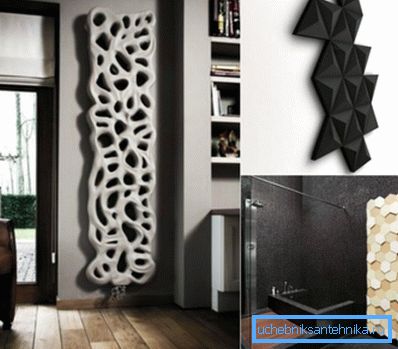
And it was not without systematization
Regardless of the manufacturer and design techniques, all radiators that fall under the definition of non-standard, are:
- Panel - analog serves as steel panel radiators;
- Tubular - a wide range of devices, while pipes can be used both independently and in the complex.
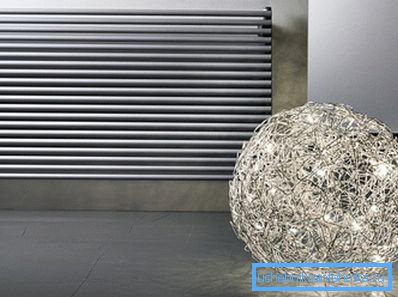
Note! There are copyright solutions, represented by the classic edges of the usual cast-iron battery. You can select them into a special niche, but we will not do this, all the same, the principle of their work is the circulation of coolant in the channels, and this ultimately is either pipes or panels.
According to the principle of work:
- Conventional water contour;
- Electric. These heaters are represented by a much larger number of author's projects. Plastic and glass are used in combination with metal. Only on one panel "mats" built numerous branded catalogs.
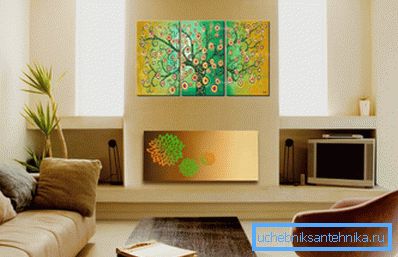
Our help! You can expand the basic classifications, add combined design solutions, installation methods: floor-standing, wall-mounted, and continue this list ad infinitum.
What is considered a copyright decision
Indeed, there are no clear criteria for defining “designer”, but still we will try to identify them.
Under the definition of the author will fall:
- Heating devices of unusual shape. Here there can be heaters of any form that makes them stand out from the usual framework of their own type;
- Radiators that have a modified texture of the coating with elements of imitation of other materials, for example, wood or stone. Or with imitation of additional elements, for example, protective screens of semi-open or closed type;
- Heaters with individual design, industrial or manual application.

Note! Having painted the radiator in the background color, and drawing on it a drawing that represents a single picture, or, using the decoupage technique and depicting several elements, you automatically convert your heater to the category of copyright. And which of them will be more original - a rhetorical question.
Criterias of choice
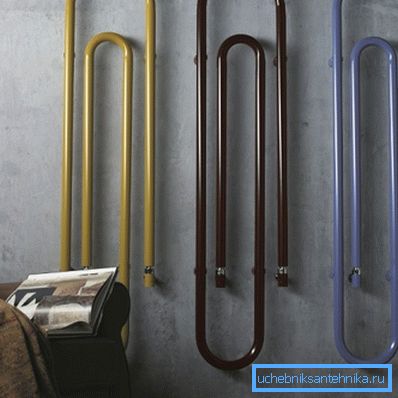
The unusual shape is good, the materials used are even better.
What are only bimetallic design radiators: reliability + aesthetics, and so for at least 20 years, but there are some nuances:
- When choosing a conventional radiator, you focus on the area of the heated room or room, and, knowing the power of one section, you can easily determine their number. When choosing the author's version, you get a heater designed for a specific area, you will not be able to add sections for complete compatibility;
- If you get the finished product you like, then be prepared for the fact that you will have to change the valves and locking valves. Standards made models do not accept changes;
- Copyright solutions do not repair their own hands, the maximum that you can do is to replace the gaskets in threaded connections.
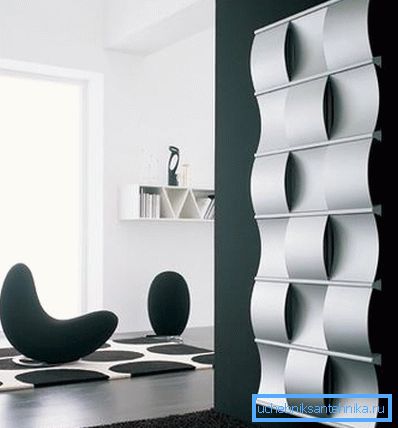
But these problems are relative and they are solved very simply:
- Many products are made to order, so the heating area is a calculated and lifting value;
- Installed American - standard. In the end, if the product price is acceptable for you, then why not at your expense establish the connections that you need;
- Designer products are designed in such a way that the batteries will work the whole declared period.
Mounting options
Installing designer radiators is no more difficult than installing conventional radiators.
The installation algorithm is completely identical, except for the fact that you do not have to do the strapping:
- Installation of designer radiators begins with determining the location of the device. The easiest way is if the heater is installed on the floor and has special legs of the stand. Designer cast iron radiators are equipped with such legs, and connecting them is easy;
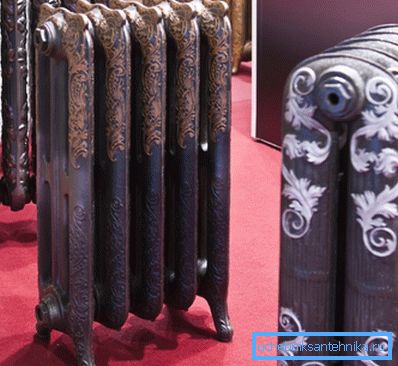
- After mounting and fixing the device, the pipes are joined to the heater. The techniques are the same: the same linen tape, the same paste for threaded connections. All manipulations are carried out with an adjustable wrench.
Note! Designer radiators are equipped with exactly the same set of strapping, they also have a Mayevsky crane to prevent airing of the system.
I want individuality
If you want individuality, but your purse cannot afford ready-made design projects, turn into a designer yourself. You can easily change the design of cast iron radiators in your home.
Here is the simplest instruction:
- The radiator is preparing to work. For this, in the summer or at any time of the non-heating season, an audit of the old paint is carried out. If the layer is uniform, without leakage and visible damage, then it can be left, otherwise be ready to work with the remover;

Tip! The edges of the battery will be the artistic polygon on which you can create your masterpiece. Therefore, the primary layer should be uniform, uniform, preferably light colors. However, by no means do we limit your imagination, like a dark background - please.
- For drawing drawing it is possible to use a cliche. To make it big on all edges or on each separately - you can decide for yourself. It is also the case with the nature of the pattern and the palette of colors;
- Figure can be completely replaced by the application. At the same time, the application can be flat with the use of drawn stickers, or it can be volumetric. In the second case, various objects are used, preferably metal, which can be painted in a single color, or highlighted in contrast or tone.
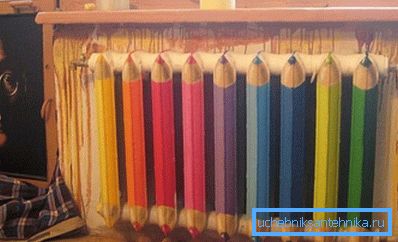
Finally
Author's developments are individual elements that do not tolerate the conveyor and pattern, therefore they are expensive. When choosing an expensive device, select the best material. The design of a bimetallic radiator will give you not only beauty, but also a reliable product for heating your home. The video in this article has prepared an additional review of the author's models.